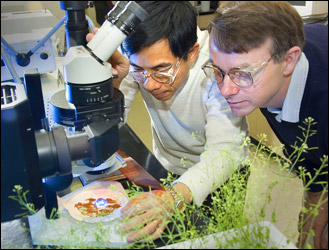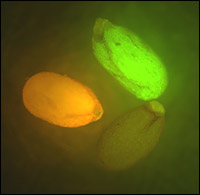New Success in Engineering Plant Oils
Technique could yield materials to replace petrochemicals and more nutritious edible oils
March 5, 2007
UPTON, NY - Using genetic manipulation to modify the activity of a plant enzyme, researchers at the U.S. Department of Energy's Brookhaven National Laboratory have converted an unsaturated oil in the seeds of a temperate plant to the more saturated kind usually found in tropical plants. The research will be published online by the Proceedings of the National Academy of Sciences (PNAS) the week of March 5, 2007.
 enlarge
enlarge
John Shanklin and Tam Nguyen working at the fluorescence microscope. (Click image to download hi-res version.)
While conversion of an unsaturated oil to an oil with increased saturated fatty acid levels may not sound like a boon to those conscious about consuming unsaturated fats, "the development of new plant seed oils has several potential biotechnological applications," said Brookhaven biochemist John Shanklin, lead author on the paper.
For one thing, the new tropical-like oil has properties more like margarine than do temperate oils, but without the trans fatty acids commonly found in margarine products. Furthermore, engineered oils could be used to produce feedstocks for industrial processes in place of those currently obtained from petrochemicals. Shanklin also suggests that the genetic manipulation could work in the reverse to allow scientists to engineer more heart-healthy food oils.
"Scientists have known for a long time that the ratio of saturated to unsaturated fatty acids plays a key role in plants' ability to adapt to different climates, but to change this ratio specifically in seed oils without changing the climate is an interesting challenge," remarked Shanklin. "Our group sought to gain a better understanding of the enzymes and metabolic pathways that produce these oils to find ways to manipulate the accumulation of fats using genetic techniques."
The researchers focused on an enzyme known as KASII that normally elongates fatty acid chains by adding two carbon atoms. The longer 18-carbon chains are more likely to be acted on by enzymes that desaturate the fat. So the scientists hypothesized that if they could prevent the chain lengthening by reducing the levels of KASII, they could decrease the likelihood of desaturation and increase the level of saturated fats in the plant seeds.
Their hypothesis was supported by the fact that scientists had previously identified a plant with a mutated KASII that showed reduced enzyme activity, and these plants were able to accumulate more saturated fats than was normal. So the Brookhaven team set out to reduce KASII activity with the use of RNA-interference (RNAi) to see if they could further increase the level of saturation in plant seed oils.
 enlarge
enlarge
Arabidopsis seeds viewed through a fluorescence microscope. Two show the fluorescent markers used to track inserted genes; the third is an unmodified, wild type seed, which appears dark. (Click image to download a hi-res version.)
The Brookhaven scientists performed their experiments on Arabidopsis, a plant commonly used in research. Like other plants from temperate climates (e.g., canola, soybean, and sunflower), Arabidopsis contains predominantly 18-carbon unsaturated fatty acids in its seed oil. Tropical plants, in contrast (e.g. palm), contain higher proportions (approximately 50 percent) of 16-carbon saturated fatty acids.
The results were surprising. The genetic manipulations that reduced KASII activity resulted in a seven-fold increase in 16-carbon saturated fatty acids - up to an unprecedented 53 percent - in the temperate Arabidopsis plant seed oils.
"These results demonstrate that manipulation of a single enzyme's activity is sufficient to convert the seed oil composition of Arabidopsis from that of a typical temperate pant to that of a tropical palm-like oil," Shanklin said. "It is fascinating - and potentially very useful - to know that we can change the oil composition so drastically by simple specific changes in seed oil metabolism, and that this process can occur independently from the adaptation to either tropical or temperate climates."
For example, such a technique could lead to the engineering of temperate crop plants to produce saturated oils as renewable feedstocks for industrial processes. Such renewable resources could help reduce dependence on petroleum.
Conversely, methods to increase the activity of KASII, and therefore the production of 18-carbon desaturated plant oils, may provide a useful strategy to limit the accumulation of saturated fatty acids in edible oils, leading to more healthful nutrition.
This work was funded by the Office of Basic Energy Sciences within the U.S. Department of Energy's Office of Science, and by Dow and Dow Agrosciences. Co-authors included Brookhaven biologist Tam Nguyen, Mark Pidkowich of the University of British Columbia, and Ingo Heilmann and Till Ischebeck of the Georg-August University of Göttingen.
The PNAS paper can be viewed online at: http://www.pnas.org/cgi/doi/10.1073/pnas.0611141104
2007-10597 | INT/EXT | Newsroom









